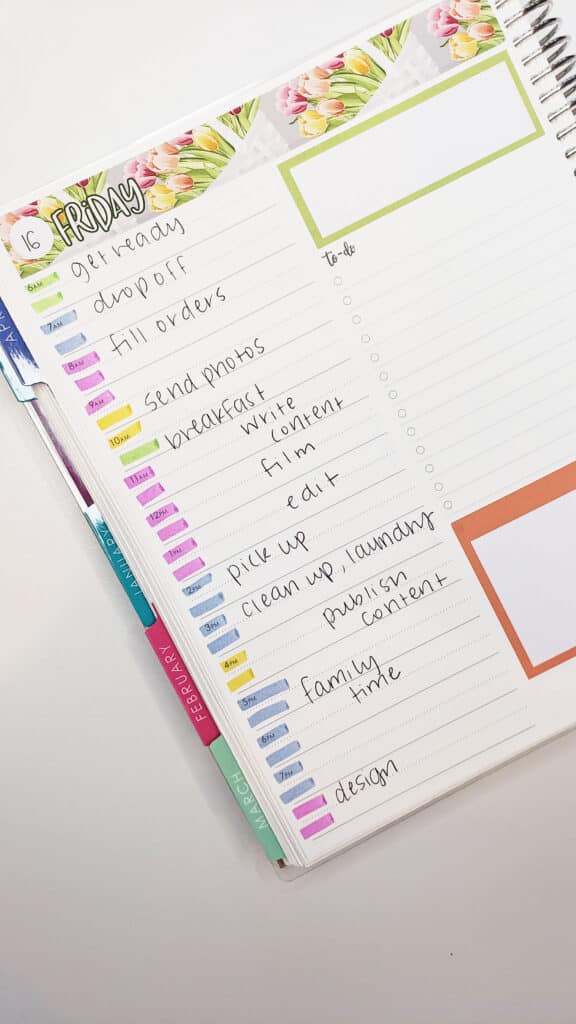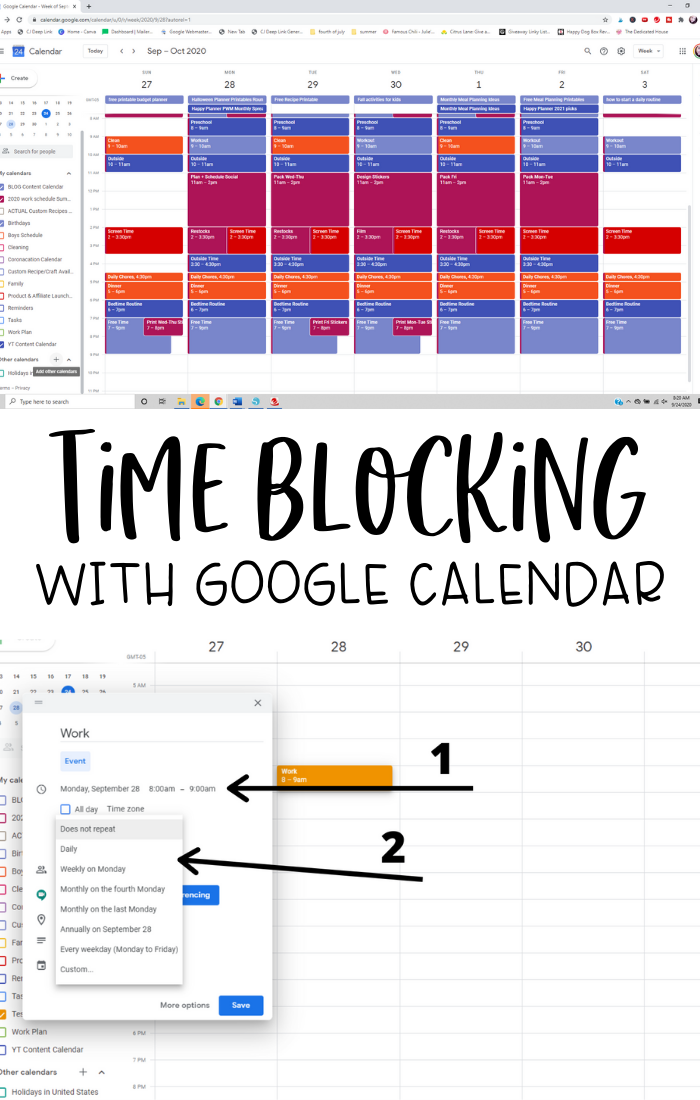How to Time Block | Time Blocking Planner Ideas
This post may contain affiliate links. See our full disclosure policy, here.
Hey planner friends, today I’m sharing all of my tips with you on how to time block in your planner! Specifically today I’m using my Daily Duo planner from Erin Condren, because it is my hourly planner of choice. You can do this in any hourly planner, or on a piece of paper, really, anywhere you have space to map out your day hour by hour to block off sections of time.
This post contains affiliate links. See our full disclosure policy, here.

Why Time Blocking is Effective
With the concept behind time blocking, you are blocking off hours of your day to dedicate them to specific tasks. This helps you to be more focused during different blocks of time on the specific task at hand. This means your brain isn’t switching between different tasks or responsibilities, and you can power through what you need to get done, until it is done. Or, if you are working on a bigger project, you can fill that block of time with work dedicated to that project and then know that when that block of time is up, that’s all the work you are doing on that project at that time, and it is time to move onto something else. When you have specific chunks of time to work on specific things, you also have a clear view of your time being limited for that task, which reduces procrastination and motivates you to limit distractions.
I find time blocking to be really helpful for me. I have currently three different businesses, I have two kiddos, and a husband and household to manage. Time blocking helps me set boundaries between business and home, and from business to business. I typically have to do something in each of my businesses daily- whether it’s delivering client work for my Etsy shop consultations, delivering photos to clients in my food photography business, or working in this business- that is Planning Inspired, which includes this blog, my Etsy shop, and a Youtube channel among other things. By assigning each business a chunk of time, and then prioritizing tasks in those time chunks, I make sure everything is getting the attention it needs and
Choosing What to Time Block
I like to combine two different time management concepts when I’m planning. I use a little of the “filling the jar” time management idea and the Eisenhower matrix, as well.
If you aren’t familiar with filling the time jar, the basic concept is this- you fill your time jar during the day by putting your largest stones (most important tasks or major commitments) first, and then you fill in your jar (your time) with the smaller stones (smaller, less important tasks), then finally, sand goes into the jar which represents filler tasks, like watching television, etc.

Sign up for my email list below for a printable pdf version of this filling the time jar worksheet!
By putting the large stones in first- doing the important things first, we make sure that we are doing our best and meeting goals we set. If we were to fill our jar with sand first, which remember, includes minute tasks like watching television and scrolling on social media, after several days or even weeks of putting the sand first, we’d find that our large stones weren’t fitting in- that we weren’t taking care of the things that are most important to our lives. This concept really helps me to maintain boundaries between work and my family, and helps me to prioritize things like my health.
Then, if you aren’t familiar with the Eisenhower Matrix- I use this mostly for business tasks. It is a concept of grouping tasks by 4 categories, usually written down on a quadrant. The upper left square includes tasks that are urgent (time sensitive) AND important, such as a work deadline or meeting. These tasks have to be focused on. The upper right square includes tasks that are less urgent, but still important. These tasks need to be done but don’t have as much of the time sensitivity. These can be done if time allows, but can also be rescheduled. The lower left square includes tasks that are urgent and time sensitive, but less important. These are often tasks that can be delegated to someone else. Some examples of this for me would be scheduling social media or another task that I’m not hiring out yet, but really should be, especially if I find myself bumping it off of my list frequently due to lack of time. At home, an example of this could be laundry. It’s urgent because we need clothes, but it is a task that can easily be done by someone else in our household. Finally, the lower right square includes tasks that are neither urgent nor important (hello, Facebook). These can be scrapped entirely, or should only be done if all the other tasks are handled first.

Download a blank Eisenhower matrix to fill out with your own tasks when you sign up for my email list below!
How to Start Time Blocking
Start time blocking by sitting down with your planner. Sometimes, when it comes to time blocking and planning my daily schedule, I do like to do this day by day, instead of planning for the whole week up front. However, you can probably partially plan- that is plug in the important time blocks that you know you want to have at the beginning of the week.
Consider other family members’ schedules. If you have children in sports, or your husband’s schedule tends to dictate your own a bit, definitely consider their schedules when you sit down to plan your time blocking. Block off any family time commitments up front. I also like to consider my husband’s schedule so my work days are lighter when he is off work and heavier on days we are both working, so that we have plenty of family time.
Next, think of filling the jar and add in your most important tasks into blocks of time. Try to be super realistic with yourself and the time it takes to complete things. Use the Eisenhower matrix if you have to decide what’s priority and what can be rescheduled, or removed from your list.
I start by blocking off time for my kids- that’s drop off times for school, and time they’re home in the afternoon before dinner, when we handle things like household chores, getting dinner ready, etc, and then before bed for family time.
Then, I block off my work hours into sections based on doing my most important tasks first. Typically for me, this would be filling orders (urgent and important), creating new content (important, but not urgent), posting to social media for my business (urgent, not important), and scrapping anything else business-wise that falls into the not urgent and not important category.
I also consider the time of day when deciding which tasks go where. For example, if I need to film a video, I need good lighting, so I’m going to want to do that during the day when there is good light out. If I’m doing something like editing or writing a blog post, that can be done whenever, and would be good to schedule during times like when I wake up early to work at 5 am, or at night once the kids are in bed.
For my thought process when I’m time blocking, and to see how I write this all out in my planner, be sure to check out the video I posted to my Youtube channel.

Schedule Time for Yourself
Lastly, I do want to remind you that when you are time blocking, it can be overwhelming to pack your day full of tasks to do. Be sure you are giving yourself some buffer space, space for taking breaks if you are at work or running a business, and then also time for yourself in the evenings or wherever you normally would take time for yourself. These times are important to include in your schedule, as well.
I hope you enjoyed these time blocking tips and my ideas on how to time block and prioritize tasks. I find them to be so helpful when I’m just overwhelmed with tasks to complete. If you have any ideas to share or questions, be sure and leave them in the comments!
If you are looking for a planner like the one I use for time blocking, you can get your own Daily Duo planner here.
Then, I have even more recommendations for the best planners with time slots!
For stickers to use with your Daily Duo, check out my Daily Duo sticker kits.





